Original publication: Highway Safety Manual Case Study 1: Using Predictive Methods for a Corridor Study in Idaho
Idaho used FHWA's Interactive Highway Safety Design Model (IHSDM) along the Idaho 8 corridor to evaluate existing traffic, roadway geometry, and predict crashes using these and the corridor's recent crash history.
Issue
Application of the Highway Safety Manual (HSM) and related safety data tools.
Key Accomplishments
“The advantage of employing IHSDM on this project was the opportunity to perform a detailed and simultaneous review within the corridor on a variety of critical elements (that is, traffic operations, geometry, safety) to isolate potential problem areas and allow development of strategic mitigation strategies.”
– Bob Beckman, Project Manager
- FHWA's Interactive Highway Safety Design Model was used to evaluate the safety and operational effects of existing traffic and roadway geometry on highways. This evaluation, along with the corridor's recent crash history, was used to predict crashes.
- While the IHSDM is a data intensive program, the time and effort invested in data entry is rewarded through the production of a detailed quantitative safety analysis.
Results
The development of a more advanced safety analysis for the Corridor Study that was data-driven and integrated into the Statewide Transportation Improvement Program (STIP).
Benefits
- The IHSDM Policy Review and Crash Prediction modules were very useful in identifying existing geometric deficiencies, specific locations needing further evaluation, locations needing possible design improvements, and potential safety issues in the corridor.
- A Corridor Plan Report was prepared to document the review, analysis, and resulting recommendations of this study to be included in the STIP for future implementation.

Figure 1: Idaho 8 Corridor

Figure 2: Idaho 8 Corridor Map
Contact
Ken Helm Senior Transportation Planner
Idaho Transportation Department
(208) 799-4229
ken.helm@itd.idaho.gov
